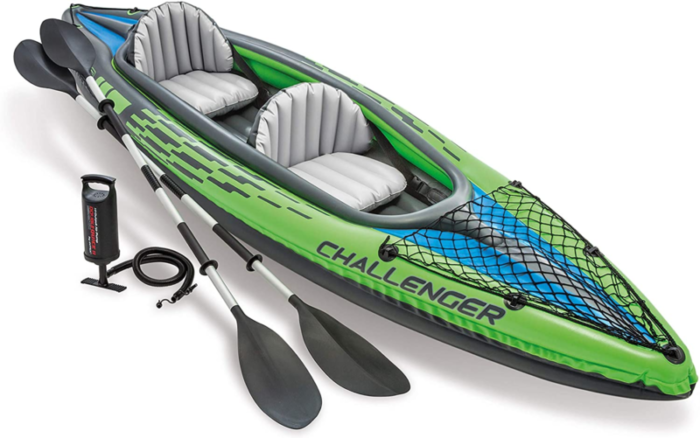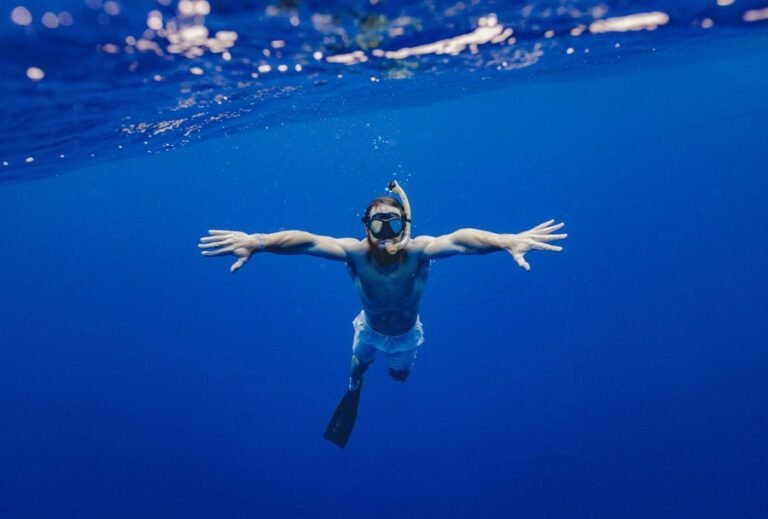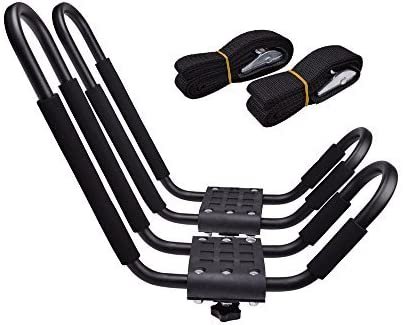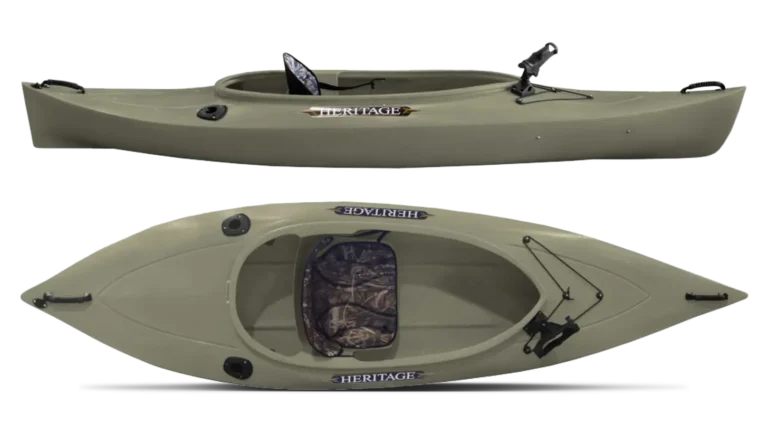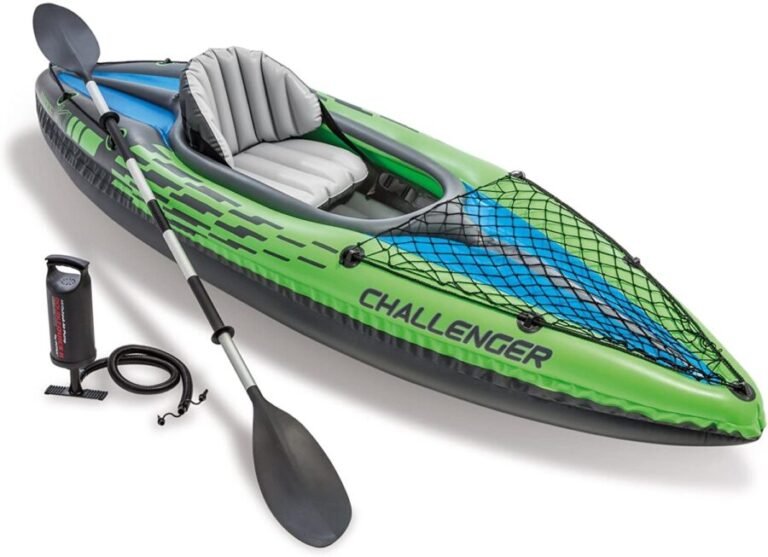Average Kayak Speed: How Fast Can You Go?

Kayaking is an excellent way to explore the outdoors and get a workout. However, not all kayaks are created equal. Some are faster than others, which can make for a more enjoyable experience.
You might desire a fast ride or a slow one depending on your mood, and knowing what to expect on the water helps you plan ahead. Most kayakers move at an average of 2 miles per hour when paddling for a long time, and that is not necessarily a bad thing.
It is a safe way to move while enjoying the scenery and getting a workout. exercise. However, if you’re not used to moving at a fast pace, it can be difficult to keep up with kayakers who are paddling faster than you.
The average kayak speed is around 5 mph, but this can vary depending on the conditions. Faster kayaks are more efficient and can cover more ground in a shorter amount of time, but they’re also harder to control.
Less-expensive kayaks are typically slower and less stable, making them better for leisurely paddling but not as good for racing or touring.
If you want to eventually keep up with your faster paddling brethren, you will need to start slow and gradually increase your speed over time.
How To Measure Kayak Speed
Kayaking is an activity that many people enjoy. The thrills of the water and the beautiful scenery set the mood just right for a relaxing workout with family and friends. Kayakers can choose between different types of kayaks, from slow and easy-going solo kayaks to faster racing kayaks.
When kayaking, it is important to know your kayak’s speed. This lets you know how much ground you can cover per unit of time, given certain conditions.
How to measure kayak speed is a question that often arises when kayakers are trying to determine their paddling speed, usually early in their kayaking adventures, when they are exploring a new place, or when they get a new kayak.
Once you are confident of your speed, you can make plans for your trip and be able to follow them because you get to your intended destination on time. However, as kayaks are watercraft propelled with the use of paddles, it can be difficult to measure kayak speed.
There are several ways to measure kayak speed, but the most accurate way is to use a chronometer. Chronometers can be expensive, so there are some methods for estimating kayak speed that are less accurate but still provide useful information.
Here are five methods for estimating kayak speed.
- Kayak Speedometer: The kayak speedometer is probably the most common method of measuring kayak speed. It’s inexpensive and easy to use, but it only measures how fast a kayaker paddles in terms of pedal strokes per minute (PSM). For example, if you paddle at a rate of 50 PSM, your kayak is doing approximately 1 mph. Although this method does not include power, it does give you a good idea about how fast you are paddling.
- GPS Speedometer: GPS speedometers are a great option for kayakers who want to know their true kayak speed. These devices measure speed in miles per hour and can be used by any level of kayaker. They are also very common as they give speed in miles per hour and require little expertise.
- Some kayakers prefer to use a water displacement meter (WDM) to measure their kayak’s speed. This meter uses air or water pressure to measure the distance traveled by the kayak at a specific time.
- You can also use a stopwatch to time how long it takes for your kayak to cover a certain distance.
- Another way to measure kayak speed is by counting strokes per minute (SPM). This method can be inaccurate if the paddler is not keeping a consistent pace, so it is not always reliable.
Factors Affecting Kayak Speed
Kayakers have different speeds for a variety of reasons. Some kayakers are fast due to their muscle mass and some are fast because they are experienced paddlers.
Kayaks also come in different shapes and sizes, which affects how fast the kayaker can go. The weight of the kayak, the type of water, and the wind all affect how quickly a kayaker can travel. We dive more into this below.
Wind conditions
Winds affect kayak speed in a few ways.
- The first way is by how much the wind affects the amount of drag created when paddling. Drag is caused by the weight of the kayak and wind resistance. The more resistance there is against the wind, the slower the kayak will travel.
- Another way that winds affect kayak speed is by how much power the wind provides to the paddler. This power is called windage. The more power you have against the wind, the faster your kayak will travel.
- When the wind is from the side, it can cause a kayaker to lean to one side, which decreases their speed. When the wind is from behind, it can push the kayaker forward. In both cases, this decreases their speed.
- The wind also affects the angle at which the paddle is moving, which can affect how fast the kayaker can travel.
- The wind can make paddling difficult and slow you down. The wind can get pretty strong, and the paddlers could find themselves at a disadvantage because of it. Strong winds make it hard to paddle straight, especially in open water where you are exposed to the wind and waves.
Water conditions
Kayaking on a river or lake can be a great way to get in some exercise and have some fun. However, the conditions of the water can have a big impact on kayak speed. When the water is cold and murky, kayakers can struggle to move quickly.
Conversely, when the water is warm and clear, kayakers can travel at high speeds. In between these extremes are waters that are just right for kayaking, with a moderate amount of clarity and temperature.
If the water is too rough or fast-moving, it will slow down your kayak and make it more difficult to move through the water.
In addition, if the water is too smooth or calm, your kayak will not be able to reach its full speed. In many cases, kayak speed can also be affected by the type of water in which you are paddling.
The Kayaker’s Technique
Kayaking is one of the most popular forms of water sports. It can be enjoyed by people of all ages and fitness levels. Kayaking is also a great way to get a cardiovascular workout.
However, if you are not using the right technique, your kayak may not be as fast as it could be. Here is a look at how to improve your kayaking speed and techniques:
- Start by getting comfortable in your kayak. Make sure that your seat is far back enough to keep you balanced and in a stable position. If you are not comfortable, your body will still move around while paddling, so it will be harder to maintain good speed and control.
- Get used to the movement of your kayak. This will help you get more efficient at paddling.
- Practice your paddling and rowing technique: if you want to go faster, or if you want to improve your strokes, try out different techniques.
- Keep your kayak upright during the entire stroke – this will help to keep the kayak moving forward at a consistent speed.
- Use a paddle that is at least 6 feet long – the longer the paddle, the faster you will go.
- Use a broad stroke – when your paddle is parallel to the water surface it’s easier to move the kayak forward.
- Try to keep your kayak at a constant speed – if you are too fast, then you will lose control of the kayak and it will go into a spin; if you are too slow, then the kayak’s movement will become very jerky.
- Practice in calm waters so that you can get used to it, and practice in conditions where you will be comfortable.
- Knowing the waterways where you are kayaking also helps you move faster as you already know what to expect. Caution is required when exploring new waterways to ensure safety.
The Kayak’s Design
Many factors affect kayak speed, but one of the most important is the design of the kayak. Kayaks with a flat bottom and symmetrical sides make for faster kayaks, while those with a V-shaped bottom and asymmetrical sides are slower.
Other factors that affect speed include weight distribution, size and shape of the cockpit, bow storage, and type of rudder or skeg.
The Kayaker’s Seating Position
Kayaking is a great exercise that can be enjoyed by anyone. Kayakers have long known that the position of the seat in the kayak affects the speed. Paddlers seated further back travel at a faster speed than those sitting closer to the bow or stern. There are several reasons for this.
- When seated farther back, paddlers’ bodies are in a more upright position and they can generate more power with their arms and legs.
- The backward motion of the kayak prop forces water against the bow and stern, pushing the kayaker forward. When sitting in the cockpit with your legs stretched out in front of you, your body weight presses down on these two surfaces, which helps to propel you forward.
- The forward motion of the kayak is opposed by the resistance of the water’s surface. Situated further back in the kayak, you’re relying on less resistance and can therefore go faster.
Remember, the further back you sit, the faster you will go. Conversely, sitting closer to the front of the kayak means that you will go slower. Sitting in the middle of the kayak provides a good balance and allows for an easy and comfortable pace.
Kayak Gear
Kayakers have different preferences for gear in their kayaks. Some like to pack as little gear as possible to maximize speed, while others like to bring a variety of items for emergencies or comfort.
The amount of gear you have also affects the kayak’s speed. For example, if you have a lot of gear in your kayak, it will slow you down because it takes up more space and makes it harder to move through the water.
By packing light, you can enjoy the peaceful experience of paddling through nature at your own pace. If you want to go fast, you’ll need to reduce the amount of gear you bring. Here are five tips for going faster in a kayak:
- Don’t overload your kayak. Bring only what you need.
- Keep your weight centered in the kayak. Be careful not to overload the bow or stern.
- Keep your weight in the middle of the kayak. If you are using a spray deck, try to keep most of your body weight in the center.
- Sit low and don’t extend your knees too far past the sides of the kayak.
- Keep your shoulders low and snug against the sides of the kayak.
The Kayaker’s Weight
Kayakers vary widely in weight, and the percentage of body weight that a kayaker carries affects both the kayak’s speed and stability. A lighter kayaker has more buoyant bodily weight and can move through the water at a faster speed, but is less stable in rough seas.
A heavier kayaker has more resistance to movement through the water and may require more effort to paddle at a fast speed, but is less likely to capsize.
For example, a kayaker who is 200 pounds and 6′ tall will have a much different experience than a 125-pound person and a 5’2″ person in a kayak of the same size. The larger person will experience more drag while paddling, which will slow them down.
There is also the fact that a heavier kayaker will most likely be able to paddle faster to increase his speed. Ultimately, while the kayaker’s weight affects speed, little can be done about it.
Kayakers should always use watercraft that match their body weights. With good technique and favorable conditions, even a heavy kayaker can go pretty fast on the water.
The Kayaker’s Experience
The kayaker’s experience affects the kayak’s speed. A person with a lot of experience in the water will move more quickly than someone new to kayaking.
Experienced kayakers have more control over their kayak and can move it through the water more quickly. They also have a better understanding of how the kayak behaves in different water conditions and how to maximize speed in them.
The Kayak’s Size And Weight
Kayaking is a great way to get a workout and see some amazing scenery. Kayaks come in different sizes and weights. The kayak’s size and weight are two important factors that affect the kayak’s speed.
They affect the kayak’s speed because they influence how much power the kayaker can apply to the paddle. The more power the kayaker can apply, the faster the kayak will travel through the water.
Kayaks that are larger and heavier require more power to move through water, while kayaks that are smaller and lighter allow for more acceleration and less drag.
In simpler terms, a smaller kayak will travel faster than a larger one, and a heavier kayak will travel slower than a lighter one given the same conditions.
The size of the kayak is also important. The kayak’s width and length affect speed. A wider kayak moves through the water more slowly than a smaller one does.
The weather
Kayaking is a great way to beat the heat, but it can also be challenging in the wrong weather conditions. Bad weather makes for a terrible experience on the water and influences the kayaker’s speed directly.
Kayaking in low luminosity for instance is extremely dangerous and the kayaker has to move slowly and be cautious if he really wants to be safe on the water. Kayaking on a rainy or very sunny day is also not the best idea as those conditions pose hindrances to having a good time on the water.
The rain can quickly turn the waves against you while reducing visibility, making you unaware of your surroundings and an easy target for danger. A particularly sunny day will act as your natural enemy, dehydrating you quickly and making you very exhausted and unable to relax.
It will also leave you feeling hot and unable to concentrate. Cold weathers are as unfriendly to kayakers as their warmer counterparts and bring with them the risk of hypothermia.
The best weather conditions are those in between that let you have a good workout while enjoying the scenery and having fun. Checking the weather forecast before planning a trip on the water cannot be overemphasized. Doing the right thing will keep you safe.
The right kayaking weather will help you paddle at your best and avoid encountering pesky waves and strong currents. Here are five tips for enjoying kayaking in any weather condition:
- Always dress appropriately for the weather. Kayakers should wear long pants, a long-sleeved shirt, and sturdy shoes to avoid getting wet and cold while paddling. Also, you should avoid wearing cotton clothes, as they can get wet easily and dry slowly bringing the risk of hypothermia. If it’s sunny out and you’re in the water, wear sunscreen to protect your skin from the sun’s harmful rays and stay hydrated to avoid getting overheated.
- Always wear a life jacket. It’s crucial in case of an emergency, such as if you start to go under the water.
- Be wary when someone tells you to paddle in a particular direction. Always make inquiries and ensure the path of your adventure is safe beforehand. Having a map of the region and knowing kayaking laws in the environment is also a good idea. Don’t just rely on what someone says.
- If you’re caught in a rip, don’t try to fight it. It’s best to let the current carry you out of the area.
- Always tell someone where you are going and when you expect to return. That way you can rest assured that should something happen on your trip, aid is on the way.
- Obey kayaking rules and employ safe kayaking practices on the water.
Kayaking Accessories
Kayaking is a great way to get outdoors and enjoy the natural environment. However, if you are looking for a more strenuous experience, you can modify your kayak to make it faster.
If you sometimes feel something is lacking to make your kayak the ultimate watercraft, then customization is the path for you. Adding fins, a paddle blade extender or a rudder can all make your kayak faster.
And, if you want to go even faster, you can add a jet drive system. Adding an add-on like a skeg can decrease your kayak’s speed while adding a rudder can increase it. In addition, changing out your paddle for a quicker one or using different stroke techniques can also change your kayaking speed.
Kayaks can travel at different speeds, depending on the type of kayak, the weight of the person paddling, the condition of the water, the wind, and the paddler’s experience and abilities.
So, if you’re looking to get from point A to point B as quickly as possible, a kayak might not be the best option – but it’s still a fun way to get around!
While a kayaker can achieve a speed of 3-5 mph in most conditions, experienced kayakers can reach speeds up to 10 mph in ideal conditions. With the right techniques and practice, you can reach your desired kayaking speed.
If you are interested in learning more about kayaking and improving your speed, consider signing up for a kayaking class or workshop. Regardless of your speed, always be aware of your surroundings and be sure to use proper safety precautions when kayaking.
Remember that while speeding when kayaking is thrilling and makes for a much more enjoyable adventure, going too fast can lead to instability and make it difficult to control the kayak resulting in accidents. You are on the water to have fun but stay safe while doing so. Have fun on your adventures.

